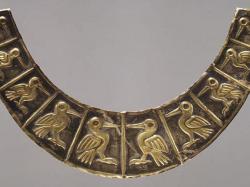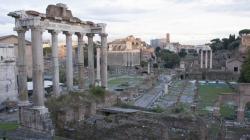INSTITUT SUPERIEUR D'ANTHROPOLOGIE
INSTITUTE OF ANTHROPOLOGY
ONLINE COURSES / COURS A DISTANCE
FALL TERM : OCTOBER 2014
REGISTER NOW
INDE –  Dannanapeta - The Dolmens of Dannanapeta, megalithic structures dating back to 1000 BC, could be lost forever unless something is done urgently by the state government to secure them, feel heritage conservationists.This particular site in Srikakulam district, which is one of the few megalithic sites in the world to be still standing, has been vandalized by locals and encroached upon by none other than the government. While one portion of the megalithic site has been converted into an acacia plantation by a liquor baron, who allegedly bought the plot of land from another land shark to whom the land was allegedly sold by locals, another part has been encroached upon by the Government Polytechnic that has come up over the past couple of years.Amateur archaeologist Venkateswar Rao, who discovered the site in 1999, said: "When I found the site there were about seven minor and disturbed dolmens and one large dolmen, originally with 18 supports. Now what is left of the large dolmen is just six supports, even as two to three of the minor dolmens have been razed. It is sad that the site has been left unprotected."
Dannanapeta - The Dolmens of Dannanapeta, megalithic structures dating back to 1000 BC, could be lost forever unless something is done urgently by the state government to secure them, feel heritage conservationists.This particular site in Srikakulam district, which is one of the few megalithic sites in the world to be still standing, has been vandalized by locals and encroached upon by none other than the government. While one portion of the megalithic site has been converted into an acacia plantation by a liquor baron, who allegedly bought the plot of land from another land shark to whom the land was allegedly sold by locals, another part has been encroached upon by the Government Polytechnic that has come up over the past couple of years.Amateur archaeologist Venkateswar Rao, who discovered the site in 1999, said: "When I found the site there were about seven minor and disturbed dolmens and one large dolmen, originally with 18 supports. Now what is left of the large dolmen is just six supports, even as two to three of the minor dolmens have been razed. It is sad that the site has been left unprotected."
http://timesofindia.indiatimes.com/city/visakhapatnam/Demolition-of-dolmens-continues-unfettered-in-Dannanapeta/articleshow/38577686.cms
PEROU –  Loma Negra - Peruvian cultural artifacts are making their way home from all over the world— Sweden’s return of the Paracas textiles being a particularly high-profile incidence of repatriation. Now, the regional government of Piura is looking to get back 400 pieces currently housed in the Metropolitan Museum of Art in New York. El Comercio reports that the pieces in question were found in the Loma Negra cemetery, an area in which a number of Mochica elite were buried. Grave robbers sacked the tombs in the 1960s, and no extensive investigation into the site has been carried out, writes El Comercio. According to El Comercio, the pieces arrived in New York in the 1970s, and include metal masks made of copper and gold as well as a large amount of ceramic objects.
Loma Negra - Peruvian cultural artifacts are making their way home from all over the world— Sweden’s return of the Paracas textiles being a particularly high-profile incidence of repatriation. Now, the regional government of Piura is looking to get back 400 pieces currently housed in the Metropolitan Museum of Art in New York. El Comercio reports that the pieces in question were found in the Loma Negra cemetery, an area in which a number of Mochica elite were buried. Grave robbers sacked the tombs in the 1960s, and no extensive investigation into the site has been carried out, writes El Comercio. According to El Comercio, the pieces arrived in New York in the 1970s, and include metal masks made of copper and gold as well as a large amount of ceramic objects.
http://www.peruthisweek.com/news-peru-seeks-repatriation-of-400-cultural-artifacts-from-new-york-103496
See the artifacts Peru wants repatriated from New York
http://www.peruthisweek.com/news-see-the-artifacts-peru-wants-repatriated-from-new-york-photos-103506
ITALIE –  Rome - The government of Azerbaijan has reportedly donated 1 million euros (£790,000) to the Italian capital, Rome, so it can begin excavating the city's Imperial Forum. The plans, spearheaded by Rome Mayor Ignazio Marino, are to eventually create an archaeological park in the middle of the city by linking the Imperial Forum to other Roman forums built by the emperors Augustus, Caesar, Trajan and Nerva, the Ansa news agency reports. The donation from Azerbaijan would fund the first phase of the project - digging for artefacts under pedestrian street Via Alessandrina - and connect the Imperial Forum to Trajan's Forum for the first time. "We believe we'll find sculptures and key architectural fragments," says city archaeology suprtintendent Claudio Parisi Presicce. Meanwhile, the city will continue fundraising and the mayor says he is in contact with Italian and international philanthropists.
Rome - The government of Azerbaijan has reportedly donated 1 million euros (£790,000) to the Italian capital, Rome, so it can begin excavating the city's Imperial Forum. The plans, spearheaded by Rome Mayor Ignazio Marino, are to eventually create an archaeological park in the middle of the city by linking the Imperial Forum to other Roman forums built by the emperors Augustus, Caesar, Trajan and Nerva, the Ansa news agency reports. The donation from Azerbaijan would fund the first phase of the project - digging for artefacts under pedestrian street Via Alessandrina - and connect the Imperial Forum to Trajan's Forum for the first time. "We believe we'll find sculptures and key architectural fragments," says city archaeology suprtintendent Claudio Parisi Presicce. Meanwhile, the city will continue fundraising and the mayor says he is in contact with Italian and international philanthropists.
http://www.bbc.com/news/blogs-news-from-elsewhere-28367510
INDE - Dharmavaram - A site with stone age ruins has been found near Dharmavaram village in Addanki mandal of Prakasam district, according to local historian Jyothi Chandramouli. The site with six tombs in a damaged state came to light during digging operations by local workers, he said, adding that the it had similarities with the Megalithic site found at Addanki, dating back to the 5th century B.C. “It is high time Archaeological Department officials preserved the site for posterity for the benefit of Indologists and anthropologists,” he added.
http://www.thehindu.com/news/cities/Hyderabad/stone-age-ruins-found-in-prakasam/article6221642.ece?utm_source=RSS_Feed&utm_medium=RSS&utm_campaign=RSS_Syndication
ISRAEL –  Bethsaida - Researchers have discovered an extremely rare coin during excavations led by the University of Nebraska at Omaha (UNO) in the lost biblical city of Bethsaida.The highlight of the excavation was the discovery of a Judea Capta coin, which was minted by Roman Emporor Domitian during his reign of 81 – 96 CE in honor of the conquest of Judea and the destruction of Jersusalem in 70 CE by his father, Vespasian, and brother, Titus. Christie Cobb, a doctoral student at Drew University in New Jersey, discovered the coin. There are only 48 other versions of this coin that have been found, and fewer still at Biblical sites such as Bethsaida. “The coin confirms other ceramic data about the date of the large Roman period building we have been excavating for the past several years,” explained Carl Savage, Ph.D., an archeologist at the Bethsaida excavation site and director of Doctor of Ministry program at Drew University. “The coin also connects Bethsaida with the great importance that the Roman Empire placed on the quelling of the revolt in Judea and Galilee. Coupled with the other finds … it makes for interesting speculation about who ma have occupied the building.” Researchers also found a Hellenistic oil lamp with a depiction of a bearded man that could possibly be Dionysus or Silenus, two nocturnal figures from Greco-Roman mythology, as well as a Babylonian cylinder seal made out of black stone. It was in 1987 that Arav discovered the site of Bethsaida, a city that was founded in the 10th century BCE, served as the capital of Geshur, a Biblical city that was destroyed by conquest in 732 BCE. Bethsaida is also said to the home village of some of Jesus’ apostles, specifically Peter, Andrew and Philip. The city was eventually deserted due to a geological disaster in the 4th century CE.
Bethsaida - Researchers have discovered an extremely rare coin during excavations led by the University of Nebraska at Omaha (UNO) in the lost biblical city of Bethsaida.The highlight of the excavation was the discovery of a Judea Capta coin, which was minted by Roman Emporor Domitian during his reign of 81 – 96 CE in honor of the conquest of Judea and the destruction of Jersusalem in 70 CE by his father, Vespasian, and brother, Titus. Christie Cobb, a doctoral student at Drew University in New Jersey, discovered the coin. There are only 48 other versions of this coin that have been found, and fewer still at Biblical sites such as Bethsaida. “The coin confirms other ceramic data about the date of the large Roman period building we have been excavating for the past several years,” explained Carl Savage, Ph.D., an archeologist at the Bethsaida excavation site and director of Doctor of Ministry program at Drew University. “The coin also connects Bethsaida with the great importance that the Roman Empire placed on the quelling of the revolt in Judea and Galilee. Coupled with the other finds … it makes for interesting speculation about who ma have occupied the building.” Researchers also found a Hellenistic oil lamp with a depiction of a bearded man that could possibly be Dionysus or Silenus, two nocturnal figures from Greco-Roman mythology, as well as a Babylonian cylinder seal made out of black stone. It was in 1987 that Arav discovered the site of Bethsaida, a city that was founded in the 10th century BCE, served as the capital of Geshur, a Biblical city that was destroyed by conquest in 732 BCE. Bethsaida is also said to the home village of some of Jesus’ apostles, specifically Peter, Andrew and Philip. The city was eventually deserted due to a geological disaster in the 4th century CE.
http://www.unomaha.edu/news/2014/07/coin.php